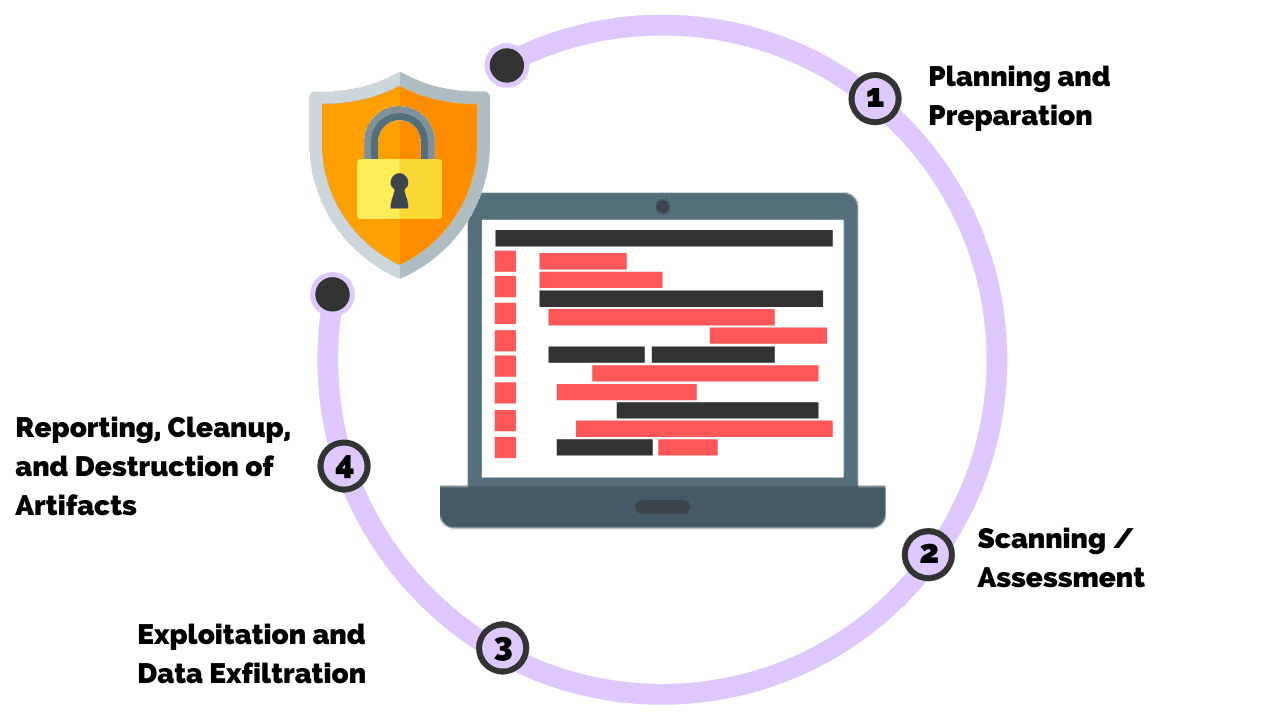Businesses rely on information technology (IT) systems to store and process their sensitive data. In order to protect this data, it is important for businesses to perform penetration tests regularly. We’ll walk you through a ten-step penetration testing methodology in this comprehensive guide. In order to get the most out of this guide, you should have a basic understanding of penetration testing concepts.
Table of Contents
What is Penetration Testing?
It involves simulating attacks on an application, computer system or network to find security flaws. Penetration tests can be used to test the security of an entire network or a single application.
Types of Penetration Tests
There are three main types of penetration tests:
Black-box pentesting: In this type of pentesting, the tester is given little to no information about the system under test. The tester is only given the name and purpose of the system.
White-box pentesting: In this type of pentesting, the tester is given full information about the system under test. This includes documentation, source code, and access to all system components.
Grey-box pentesting: In this type of pentesting, the tester gets only relevant information. This may include documentation, partial source code, or limited access to system components.
The ten-step penetration testing methodology:
Step One – Reconnaissance:
The first step in our methodology is reconnaissance. Here you simply observe, spy and collect information. This information can be gathered using both passive and active methods. Passive methods involve simply observing the system from a distance, while active methods involve interacting with the system directly.
Step Two – Scanning:
After the information gathering phase is complete, it is time to move on to scanning. This is the process of identifying which systems and services are running on the target system. This can be done using a variety of tools, such as port scanners and vulnerability scanners. In doing so, we can identify any potential security risks lurking around.
Step Three – Exploitation:
Once we have identified potential security vulnerabilities, it is time to exploit them. This is the process of gaining access to the target system by exploiting a vulnerability. The aim is to get access to the system or data that you wish to secure.
Step Four – Maintaining Access:
Once we have gained access to the target system, it is important to maintain that access. This can be done by creating a backdoor or installing a rootkit. This will allow us to keep our access even if the security vulnerabilities are patched.
Step Five – Covering Tracks:
After we have gained and maintained access to the target system, it is important to cover our tracks. This means removing any evidence of our presence on the system. This can be done by deleting log files or using encryption.
Step Six – Reporting:
When we’ve completed all of the previous activities, it’s time to share our findings. This document should contain all of the data you collected throughout our testing. This information can be used to help improve the security of the system.
Step Seven – Retesting:
After the security vulnerabilities have been patched, it is important to retest the system. This will ensure that the patches were effective and that the system is now secure.
Step Eight – Verifying:
After the system has been retested, it is important to verify that the patches were effective. This can be done by running a vulnerability scan or by performing a penetration test.
Step Nine – Documentation:
After the system has been verified, it is important to document all of the changes that have been made. This documentation may be utilized to assist future security upgrades.
Step Ten – Training:
The final step in our methodology is training. Here you want to educate your employees on following the best practices and training them to be vigilant. This training may be used to increase security in the future.
Conclusion
By following these ten steps, you can ensure that your system is secure and that your data is protected. If you are unable to perform all these steps, you can choose to go with some top pentesting companies that can do this job for you.
This guide should be used as a starting point for your penetration testing efforts but not as a complete guide. There is no one-size-fits-all solution to security, so it is important to tailor your testing efforts to the specific needs of your organization.
Author Bio-

Ankit Pahuja is the Marketing Lead & Evangelist at Astra Security. Ever since his adulthood (literally, he was 20 years old), he began finding vulnerabilities in websites & network infrastructures. Starting his professional career as a software engineer at one of the unicorns enables him in bringing “engineering in marketing” to reality.
Working actively in the cybersecurity space for more than 2 years makes him the perfect T-shaped marketing professional. Ankit is an avid speaker in the security space and has delivered various talks on top companies, early-age startups, and online events.
Linkedin: https://www.linkedin.com/in/ankit-pahuja/

